Public Demonstrations and Living Archaeology Weekend
Today we are so lucky because regular PLY contributor Christina Pappas is visiting us on the blog! Read on as she takes us on a virtual tour of Living Archaeology Weekend in Kentucky.

A notice board for rock climbers at the Red River Gorge.
The Red River Gorge in Kentucky is best known as a destination for world-class rock climbing, but during the third weekend of every September it’s better known for something else. For nearly 30 years, Living Archaeology Weekend (LAW) has been held in the Red River Gorge. For two days, demonstrations teach about American Indian and pioneer technologies and lifeways, archaeology, and protecting cultural resources. Friday is reserved for school children, and this past year nearly 1,200 4th and 5th graders participated in LAW. On Saturday, the general public is invited to join in on the fun. Demonstrations range from atl-atl (spear) throwing to long rifle hunting and it’s hard not to learn something new. Most people don’t know how important textiles were in ancient and early historic lifeways, but a group of us at LAW are changing that.

Sunrise at the gorge the morning of LAW.
This was my third year demonstrating ancient spinning and weaving at LAW. I’m still new to this method of demonstrating and teaching; every year feels completely different. The weekend is a whirlwind of activity. My first year at LAW, I assumed this would be like any other event where I demonstrated ancient textile techniques. There would be some polite interest and a few questions, maybe a handful of folks who would want to dig a little deeper into the technique. LAW is anything but. On Friday, the school kids are an explosion of energy and excitement. I always start by asking them what ancient people would have worn thousands of years ago. Animal skins are always a standard answer and I love to see their astonished faces when I show them the soft fabric made from local plants used for clothing. I show them how to twist plant fiber into yarn and then they get to try prehistoric weaving. The boys usually become shy and let the girls take the lead. This year was different. My husband demonstrated the weaving and once the boys realized this wasn’t just ‘woman’s work’, they had as much fun, and success, weaving
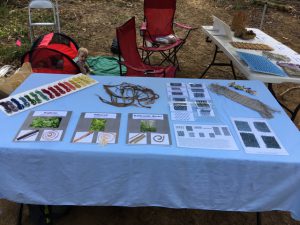
My demonstration table at LAW. I have examples of different types of textiles, some plants used for fiber, and a rainbow of color from natural dyes. The colors possible from natural dyestuffs always impresses my visitors. Also note the adorable baby playing in the back.
What makes LAW really challenging is that you only have a few minutes with each group of kids. I have to summarize 40,000 years of textile technology and teach how to make yarn and how to weave in 10-15 minutes. It’s a bit exhausting but in the end it’s worth it. My demonstration breaks so many misconceptions for these kids. Ancient peoples wore clothing as vibrant and interesting as we do that told as much about them as our clothes tell about us. LAW helps these kids learn that the stereotypes about ancient peoples they have grown up with are often wrong. It
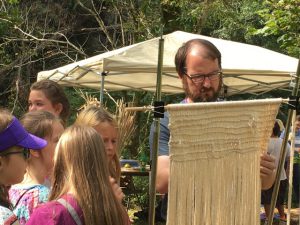
My husband Chris demonstrates a type of prehistoric weaving, twining, to school children. The boys always seem reluctant to try the weaving because ‘that’s what girls do’ but seeing a man take the lead on the actual weaving inspired them to give it a go.
I’m not alone in my textile-themed demonstrations. Robin McBride Scott demonstrates basketry techniques that have been used since ancient times. A self-taught basketmaker, Robin has been demonstrating at LAW for 13 years. Like me, Robin has found that the kids at LAW arrive with a lot of misconceptions about the ancient past. She tries to get them to see baskets as tools and not just a decorative art piece on the shelf, how changes in the basket weave can change the strength and use of the finished object, and the role baskets played in our technological evolution.
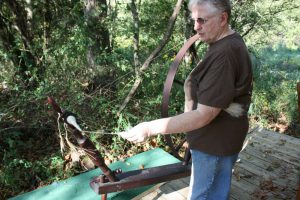
A great wheel is the show-stopper for kids at the historic spinning demonstration at LAW. Most of the kids have never seen a spinning wheel in person, let alone a great wheel.
LAW has become one of my favorite fiber-related activities all year. It is exhausting, but it’s always so much fun. Demonstrating at LAW has made me really think about what is most important for people to learn about spinning and weaving. When you only have a few minutes of a child’s attention, you have to make sure what they take away from you matters. Knowing that ancient people spun and wove and that the stereotypes are wrong is what matters to me.

Chris is an archaeologist by day and a fiber fanatic by night who is happiest when she can be both at the same time. She lives in Kentucky with her husband, adorable baby girl, and two crazy beagles.

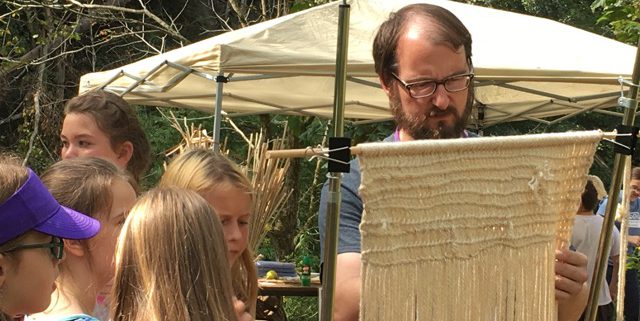
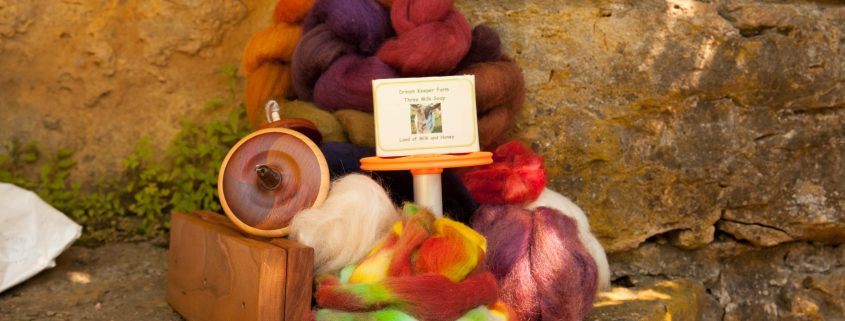

 She felted and I spun, and while we worked away we chatted, shared stories and happy silences, and all around enjoyed the satisfaction of being with someone who really, really gets what you do. Oh, and tea. We drank lots of that.
She felted and I spun, and while we worked away we chatted, shared stories and happy silences, and all around enjoyed the satisfaction of being with someone who really, really gets what you do. Oh, and tea. We drank lots of that.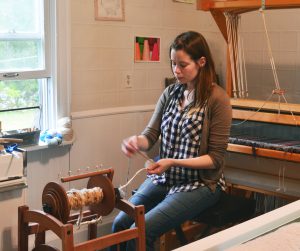 There are the obvious benefits of course: talking, laughing, having fun, and the joy that comes with sharing. Here are some other great reasons for building your own fiber community:
There are the obvious benefits of course: talking, laughing, having fun, and the joy that comes with sharing. Here are some other great reasons for building your own fiber community: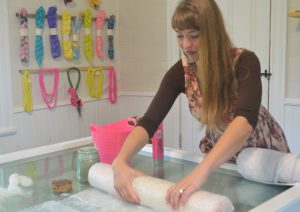 Need some help finding YOUR community? Here’re some ideas to get you started:
Need some help finding YOUR community? Here’re some ideas to get you started:
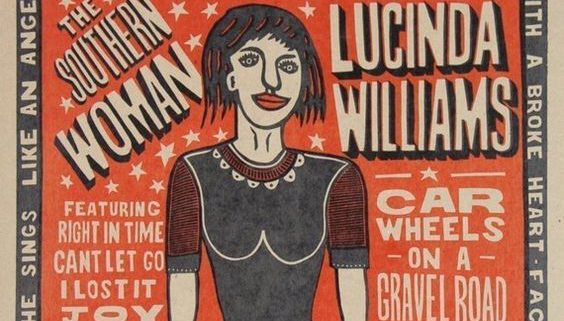


 The word bouclé is French for “buckled,” which makes sense because a bouclé yarn is bent back on itself, creating loops of yarn along the strand. This technique takes time to create and even more to master, but we think it’s a worthwhile endeavor! This textured yarn can be light, airy, big and bulky – all at the same time! Dig into this issue and brush up on your bouclé making skills with us!
The word bouclé is French for “buckled,” which makes sense because a bouclé yarn is bent back on itself, creating loops of yarn along the strand. This technique takes time to create and even more to master, but we think it’s a worthwhile endeavor! This textured yarn can be light, airy, big and bulky – all at the same time! Dig into this issue and brush up on your bouclé making skills with us!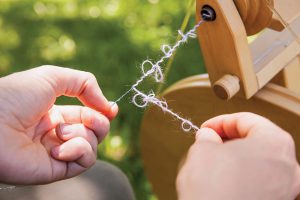 Offended Fiber: Woolen Prep for Bouclé, by Jillian Moreno – What happens when you deviate from the standards? Jillian finds out in her exploration of building a bouclé using woolen-spun wool instead of worsted-spun mohair.
Offended Fiber: Woolen Prep for Bouclé, by Jillian Moreno – What happens when you deviate from the standards? Jillian finds out in her exploration of building a bouclé using woolen-spun wool instead of worsted-spun mohair. Spin It! Silk Bouclé, by Coleen Nimetz – Silk is often used as a core or binder for bouclé, but it might surprise you to learn that it makes a pretty interesting wrapper, too.
Spin It! Silk Bouclé, by Coleen Nimetz – Silk is often used as a core or binder for bouclé, but it might surprise you to learn that it makes a pretty interesting wrapper, too. Sieve Cowl, by Brittany Wilson – This cowl is business in the back and a party up front – perfect for wearing with a jacket to keep you warm without a lot of bunching at the back of your neck.
Sieve Cowl, by Brittany Wilson – This cowl is business in the back and a party up front – perfect for wearing with a jacket to keep you warm without a lot of bunching at the back of your neck. We know that bouclé is a tricky technique to master, so in Tip Jar we’re rounding up the best tips from our readers to help you spin with success. Scene is full of things on the spinning scene that you’ll want to know about including new books from Beth and Jillian, fiber festivals and fantastical retreats, and a brand-new magazine for men. And don’t forget to check out our Independent Spinner page to find all the details on the products featured in this issue!
We know that bouclé is a tricky technique to master, so in Tip Jar we’re rounding up the best tips from our readers to help you spin with success. Scene is full of things on the spinning scene that you’ll want to know about including new books from Beth and Jillian, fiber festivals and fantastical retreats, and a brand-new magazine for men. And don’t forget to check out our Independent Spinner page to find all the details on the products featured in this issue!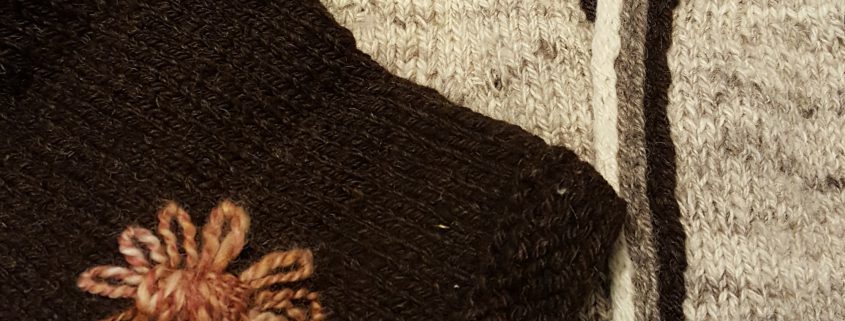
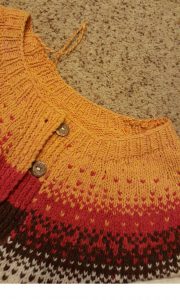
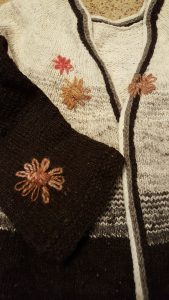
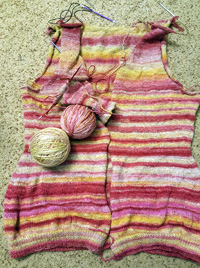 I called Amy! She found her electronic copy! She answered my question. Now I’m moving forward. The body of the sweater is finished and I’m working on the first sleeve. But I have another issue. The yarn is made from BFL/Silk that was specially dyed for me – also by Amy King (Spunky Eclectic) I have no more to spin and I think the sleeves are going to be tight and I still have edgings to do…
I called Amy! She found her electronic copy! She answered my question. Now I’m moving forward. The body of the sweater is finished and I’m working on the first sleeve. But I have another issue. The yarn is made from BFL/Silk that was specially dyed for me – also by Amy King (Spunky Eclectic) I have no more to spin and I think the sleeves are going to be tight and I still have edgings to do…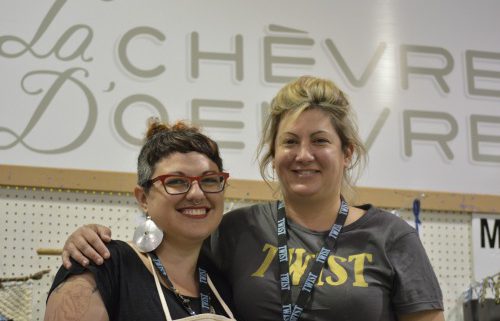
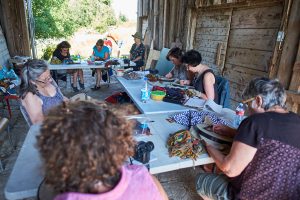
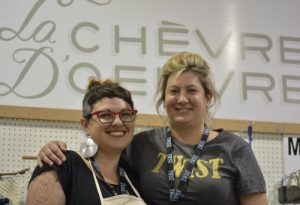
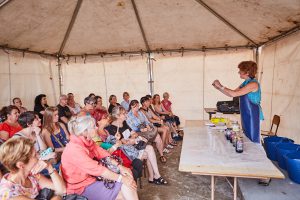
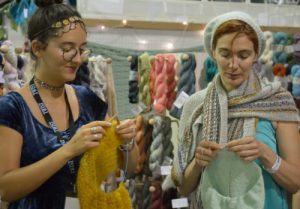

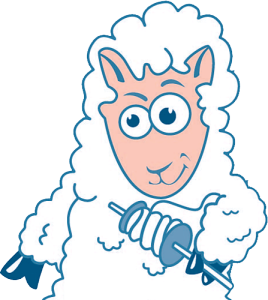

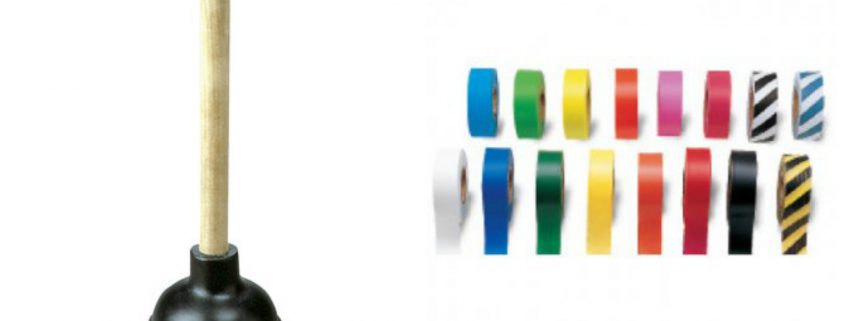
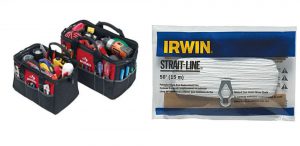
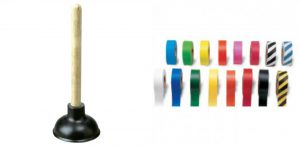 a sink plunger once to know I found finishing nirvana. I use it mostly when I want wool yarns more than just fulled.
a sink plunger once to know I found finishing nirvana. I use it mostly when I want wool yarns more than just fulled.